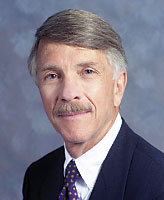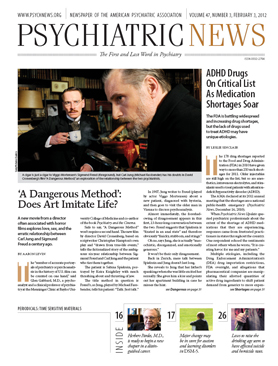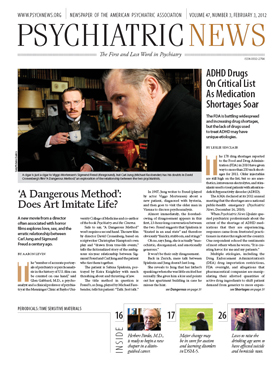As your president, I was privileged to be invited to a meeting on January 10 at the White House concerning a remarkable initiative launched by First Lady Michelle Obama and Dr. Jill Biden, called “Joining Forces.” Dedicated to improving public education about “the invisible wounds of war,” this effort is particularly focused on families of returning soldiers suffering from PTSD, TBI, and combat-related depression. Goals of the program include educating the public about these conditions, facilitating access to mental health care, and increasing opportunities for meaningful employment of veterans.
The original plan was for a two-hour “Joining Forces Roundtable” to bring officials from the Department of Defense (DoD) and the Department of Veterans Affairs (VA) together with leaders from a wide range of health care organizations including APA, AMA (our own Jeremy Lazarus was there as president-elect of the AMA), Association of American Medical Colleges, American Nurses Association, National Association of Social Workers, American Psychological Association, American College of Physicians, American College of Surgeons, and many other organizations. Thanks to the farsightedness, however, of Mary Winnefeld, wife of Adm. James A. Winnefeld Jr., vice chair of the Joint Chiefs of Staff, the event was extended to include a reception at the Winnefeld home (“Quarters 8” at Fort Myer) the evening of January 9 and a tour on the morning of January 10 of the National Intrepid Center of Excellence (NICoE) at Walter Reed in Bethesda, Md.
The “icebreaker” reception in the Winnefeld home (in times past, the home of Gen. George Patton) allowed people whose paths don’t ordinarily cross to meet and talk informally. I had the chance to speak with the surgeons general of the Army and Navy, the commandant of the Marines, and many other key players in the DoD and VA, all of whom shared high levels of concern about the stigma that is so prominent within our service men and women, associated with PTSD, TBI, or depression. (Several weeks previously, Jay Scully and I were invited to the Pentagon to meet with the vice chief of staff of the Army, Gen. Peter Chiarelli, about similar concerns. The general estimated that about half of the troops who need help for these and other conditions do not get it, mostly because they fear negative career repercussions if they seek psychiatric treatment.)
The next morning we were privileged to be given a tour of NICoE, a truly awesome state-of-the-art outpatient facility for intensive outpatient assessment and rehabilitation for soldiers who have TBI or who are experiencing posttraumatic stress. Participating troops are referred and put on temporary duty for four weeks, during which they undergo high-technology brain imaging, neuropsychiatric and neuropsychological evaluation, and specialized interventions such as simulated virtual programs for exposure and response prevention for PTSD and an amazing Computer Assisted Rehabilitation Environment system to help soldiers with TBI regain balance and appropriate navigation through different simulated environments. Apartments are incorporated into NICoE so that families can participate in the program as well.
In addition to the tour, there were concise presentations (timed with military precision!) on the complex challenges relating to combat injuries. Vice Adm. Matthew Nathan, for example, told us that the U.S. military now has the highest survival rate in the history of combat. The average length of time it took in World War I, World War II, and Vietnam to return a wounded soldier from the site of combat injury to stateside was 45 days; now it is three days. The average time it took in Iraq to have a wounded soldier on the operating table was 22 minutes, made possible by specially equipped aircraft, essentially “flying ICUs.” And the “signature wounds” of the Iraq and Afghanistan wars have been amputations and TBI and PTSD. These are remarkable advances in military medical care, and they greatly increase the need for postcombat treatment and rehabilitation. We learned a great deal about programs in the VA and DoD to meet these needs.
The Joining Forces Roundtable itself occurred at the White House and began with an eloquent presentation by First Lady Michelle Obama, who spoke passionately about the burdens facing returning soldiers and their families. She emphasized the need for partnerships between the government-sponsored programs and the entire field of academic medicine, one of the key meanings behind the “joining forces” term for the project. Other presenters included Dr. Jonathan Woodson, assistant secretary of defense for health affairs; Dr. Chip Rice, president of the Uniformed Services University of the Health Sciences; Dr. Robert Petzel, undersecretary for health; and others representing DoD and the VA.
In the last hour of the meeting, each of us was asked to summarize our activities to date in this joint effort. Paul Burke, representing the American Psychiatric Foundation (APF), joined me, and we summarized what APA has been doing, such as our military track at our annual meeting and our participation in the “Give an Hour” program. I informed the group about the support by APA and APF for “Healthy Minds,” the public television series hosted by Jeffrey Borenstein, M.D. I mentioned that in 2010, the series had an Emmy-nominated episode titled “PTSD: Helping Our Troops,” which can be viewed at
http://watch.wliw.org/video/1317629220/. The upcoming season features episodes with former Chairman of the Joint Chiefs of Staff Adm. Mike Mullen and his wife, Deborah, as well as Col. David Sutherland, special assistant to the chairman of the Joint Chiefs of Staff. I indicated that we would like to add an episode on the “Joining Forces” initiative, an offer that was immediately accepted. All in all there was shared enthusiasm that together this partnership could really make a difference, and APA was recognized as a key player to help make that happen.



